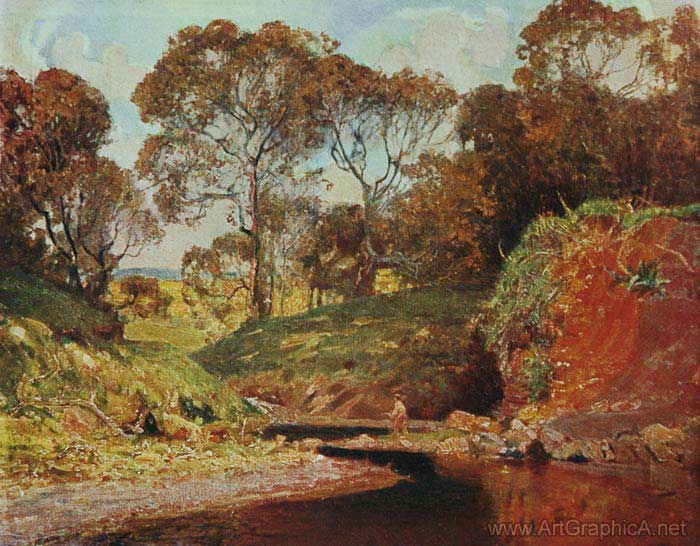What is Colour? |
|||||||||||||||||||||
|
Page 07 / 14
COLOURCHAPTER VIWHAT is Colour ? We understand well enough the general meaning of the term, but cannot easily frame a definition. Some day, perhaps, colour will be defined as chemical compounds are, and described quantitatively, a definite figure being employed for a definite tone. At present our definitions are loose, and we cannot explain the exact measure and meaning of our words when we speak of colour. We ought to have such definitions as will leave no doubt in the reader's mind as to the tone the writer refers to ; and we should associate the exact tone of a colour with an accepted symbol. We call yellow, yellow ; yet there are a hundred tones of yellow, from the most brilliant suggestions of light, to the deep hue which lies on the borderland of red. We have no names for these except " light " or " dark," and very weak epithets they are, and absolutely worthless to the artist. We say a sky is blue. It may be so, but you would frequently be inclined to call it green were a fragment of that pigment held up for comparison. In the works of eminent painters we see the sky painted in a fashion that suggests all the qualities of atmosphere,--distance, the sense of infinity, etc--yet if we were to compare it with Nature we should find ti.at the picture which gave these revelations was painted man degrees lower in tone than the actual sky. So again with red. It may be sumptuous, full, rich, expressive of dignity and power ; or it may be poor, mean, and unworthy of its place ; yet we call it " red " in either case. On one side it may coalesce with a blazing scarlet, or descend the purple slope towards blue. If this indefiniteness occurs in the primary pigments, what shall we say of the secondary and tertiary ones, with their infinite range of subtle greys ? It would be an impossible task to follow and describe them. It is not within the capacity of the human mind to do so. We use names which are, after all, but approximations to the real facts.  Evening in Spain. Colour cannot be expressed without a medium, or without the assistance of form, yet it has a quality independent of either. It is the significant beauty of a pearl, yet, strange to say, it is of little value when the same lovely iridescence is shown in a meaner material. We lose a vast amount of the enjoyment of life in the non-appreciation of colour in its infinite varieties and combinations. There are within our minds associations of sentiment with colour. For example, red calls up the ideas of force, cruelty, or passion ; purple speaks of dignity and regal splendour, and blue of purity, and so on. But, for all that, it has not been discovered what form or shape best serves for their display ; and if the most expressive form, let us say, of red be made, it may lose or modify its meaning through contact with its complementary. There is a wide field of unexplored thought in the question of colour and its bearing upon the emotions through art, but it is too abstruse for a book of this character. It is sufficient for our purpose to insist that the student should recognise that there is as much artistic thought necessary to the selection of colour from Nature, as there is in the selection of form, and that no colour should be allied with form, if by such alliance that form should lose its special characteristic. Our nerves may be as irritated by a series of tones of colour in a bad picture, as our ears would be by the discord of tones in music. I mention this matter, because I want to warn you that no excuse is valid for the misuse of colour. You cannot come back puling from a mis-spent month of work and say you never had a chance_ You have had chances as good as any of the painters ever had. It is entirely your own fault if you select colour that is common or mean. Some people see only the sordid elements in life and Nature ; they seize only the non-essential things which Nature would almost seem to display in contrast with the truly great. Philistine painters, mistaking these for the inner realities, and being oblivious of true place and proportion, reproduce them, and leave the characteristic things undone. So with colour. They see the obvious and superficial; they do not see what is distinguished and fine. Unfortunately their appeal to Nature for justification is allowed by those who see her with the same meanness of vision. The appreciation of colour is undoubtedly a rare gift. With it a man can become a great painter ; without it, he cannot possibly claim a position amongst them. One can cultivate this faculty if it is inborn, and develop it to a higher plane ; but if it is absent it cannot be created any more than yoit can create an ear for music. It is a well-known fact that faculties become atrophied by disuse, and exercise is necessary for the retention of natural gifts. It is said that Darwin, who used to practise music in his early days, completely lost all sense of it after a long period of life devoted to scientific pursuits. He could not not tell the difference between " God Save the Queen” and " Rule Britannia." You perceive, therefore, it is equally necessary, if we wish to keep the colour sense keen, to constantly sharpen that faculty by close observation and comparison of colours in Nature, learning to select those that will be most consistent with our purpose. The vulgar craftsman will give you the rough, primitive colours that are seen by the crowd ; but the disciplined eye perceives the qualifying effect of many different local conditions, yet never loses the truth amid these modifications. You have admired the beauty and subtle colour of the landscapes by Cazin. You cannot say for certain what proportions of yellow or blue composed his green. You cannot detect the particular pigment in his delicate greys. But you instantly recognise that he has seen these tints in Nature, and that his representation is just and beautiful. You conclude that they are arrived at through a refined and artistic temperament ; not the coarse and vulgar ignorance that paints blue blue, or green green, and leaves no message beyond the impression that the hand that painted was the hand of a boor. The lesson to you is this : While exercising care in the selection of your subject, its composition, and the effect under which you will paint it, you must think, and think seriously, of this vital question of colour. It is a question of the first importance, and probably the most profound of all the difficulties you have to encounter. If you are a colourist by nature, the time and thought you devote to the subject will not be wasted ; naturally, by thought, you will add something to the fineness of your gift. If you have but a poor appreciation of colour, it is all the more necessary to seek improvement by painstaking and persistent study. It has been said, and said with truth, that if you look for any particular colour in Nature, you will find it. If you search for purple, you will discover purple ; and if you want blue, the blue will be sure to show itself. This curious and interesting fact in psychology accounts for the preponderance of certain colours in some artists' landscapes--a specific strain, as it were, running through them all, as particular notes in a musical fugue. We know a man's work by his predilection for a certain colour, yet the artist himself may be completely ignorant of the peculiarity. It is possible you may become colour-sick, i.e. lose your quick appreciation of colour. The only remedy is resolutely to exclude the offending pigment from your box, and to force yourself to paint the subject without it. It will be difficult, and almost painful at first. You will be trying incessantly to find it on your palette, but persevere until you have conquered this abnormal tendency. Then, when you are so master of it, you may indulge yourself with a little of the forbidden colour as a luxury. The raison d'etre of painting, in contradistinction to the other arts, is the expression of colour, or rather the expression of colour allied with form. It is a laborious task to secure some of the higher qualities of tone when using a full polychromatic palette. It has been done by Turner, even if at the expense of other artistic qualities. But do not allow any difficulties to drive you to seek that refuge of the destitute--painting in monochrome. It is obviously easy to obtain qualities of tone in black and white. It is true we may even suggest colour in black and white, and there are artists who claim to suggest colour by a monochromatic scheme. But do they succeed ? That is a question I would ask you seriously to consider. They paint black or brown trees, and a grey sky made of flake-white and ivory-black, and they perhaps insert a spot of colour in the figure of an animal or man. Now, had you not received the suggestion through the form of the trees that they were trees, do you think you would feel they were green ? I think not. You feel they are green because you know by their form they are trees. If the mass had not assumed the shape of trees you would not have arrived at the conception of any colour, but would only have perceived their blackness. The suggestion is offered, and you accept it, your intellect coming to the rescue of your sensation by a process of deduction. Were all art so colourless, what a monotony it would be ; and Life minus colour -- flowers, skies, seas, costumes, pageants, reduced to dull monochrome--would become a dreariness indeed. It behoves us, therefore, not to shirk the difficulties of colour, but so to use it that it becomes a pleasure ; for the appreciation of colour is one of the joys of life--one of its greatest charms. It is our duty to cultivate this faculty--so to understand its value that we may reveal its beauty to others, and which many, in their hurry of life, may have missed. The greatest landscape is marked by the alliance of fine form with fine colour. Colour that is harmonious and just will always possess beauty. Forms should be enhanced and glorified by colour, and colour in turn should be ennobled by being enshrined in the most appropriate forms. It is said that one of the old masters declared that he would paint the head of a Madonna with mud, if he were given colour to put round it.
Next Page
Prev PagePainting Trees Art Composition
|
|||||||||||||||||||||








